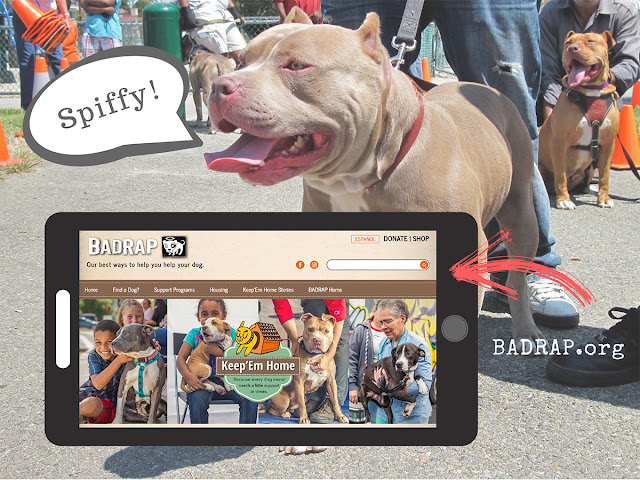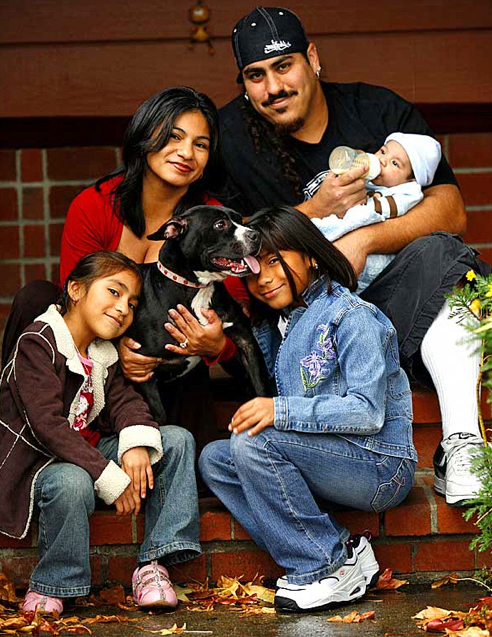 One of these pups is from a high volume kennel that is trying to shut down.
One of these pups is from a high volume kennel that is trying to shut down.
Not the pit bull. The fuzzy girl on the right came from a kennel in a remote part of NorCA. The woman who owns the kennel has been busy attracting buyers from near and far who dream of owning their very own 'wolf type dog.'
The power of marketing and personal fantasy is strong. Hundreds and hundreds of pups have been sold from this yard over the years, but the jig is up.
Along with the breeder's announcement that she wants to retire (she's 72 and facing health problems) the County is demanding that she reduce her numbers by 80% - from 130 adult dogs down to 25 adults, or else. She's told us that she wants out of the puppy business altogether. Good news, since there are only so many families to go around who are ready for the built-in challenges of a high energy dog who carries the burden of a troublesome label.
Dog rescuers have been shaking their fists at this breeder ever since her dogs started falling out of ill-prepared homes and into overcrowded animal shelters. So understandably, many scoffed at the news that she wants to retire and seemed to believe it was a ruse.
The Aftermath
Animal shelters and rescues in many parts of the country are reporting a
sharp increase in the number of homeless huskies and dogs identified (correctly or incorrectly) as Wolfdogs. We've walked this difficult path with pit bulls when Pandora's box first opened in the late 80's, so decided to contact the breeder last spring to learn about her plans and offer some help towards closing shop. She responded immediately.
Getting to this kennel from the SF Bay Area requires a lot of driving and at least one overnight, so we dialed up rescue friend Shirley from
Dogwood Animal Rescue, drove the distance and secured a veterinarian to join us. After introductions, we surveyed the endless rows of haphazardly built pens filled with dozens of bouncing, barking dogs and did a head count while trying not to look too shocked. On that day there were two hundred and twenty two (222!) dogs and puppies. As you can guess, with only two people on-site to provide care, the conditions were less than ideal.
Before you curse the breeder, remember that this situation is alive and well because it's been supported by hundreds of buyers over the years who desire her product. No buyers, no producers.
While we were there, we watched a buyer trade a frightened pup for fencing material and we held the space as the veterinarian euthanized eight troubled dogs at the owner's request. It was a tough day. Shirley unloaded a car full of donated kibble and filled it back up with four scared-to-pieces pups and one adult to head back to her rescue for TLC and rehoming. Since that visit, we've organized the spaying and neutering of the small group of adults the breeder is intending to keep. We started lists of dogs from the site titled, '
Possible Rescue Candidate,' '
Not Adoptable,' and fretted over the impossible details with our most experienced rescue and disaster response colleagues. No one seems to know how to help, to be honest. The skittish behavior of so many under socialized, escape prone dogs requires special management, but rescues are already overwhelmed with sheltered husky type dogs who've been falling out of homes. Best Friends Animal Sanctuary is full and the very real problem of
hoarding in lesser known sanctuaries is pushing responders to the wall. Funders we spoke with were unwilling to engage due to the high number of dogs who would likely be euthanized due to lack of rescue options. Some suggested that the breeder's dogs could only be helped if they fell into extreme health crisis. Then, they said, funders would allow for a disaster relief response. Until then, there were basically SOL.
Puppy Mill Behavior
In July, a transport brought eight of the breeder's puppies down to Oakland. They'd been destined for sale in a Walmart parking lot - it's how the breeder buys kibble for so many hungry adults - so we took them on to help them out, but also as a bit of an experiment. What would they be like? What kind of owners do they need?
It was clear from day one that the pups were feral and we had a big job on our hands. Wolfdog behavior? They barely look the part. Trusted Wolfdog experts believe that most of the dogs from this kennel show "low or no" wolfy content. They're mostly husky-german shepherd mixes, they tell us. And boy are they shy. It's not uncommon for generations of tightly bred dogs who have no life outside of their pens to produce timid, socially insecure pups. 'Puppy mill behavior,' it's called.
The pups ran and hid from us like wild raccoons their first days here and screamed all night for their mama. It was a long first few days. To wriggle their confidence up a notch or more, we brought in the best reinforcements: Cans and cans of soft food, spoons and human vending machines, and our secret weapon - some of the most human friendly dogs known to humankind. Pit bulls, of course.
Since day one, social butterflies
Scamp (below),
Hennie and
Bernadette have been modeling the most ridiculously friendly behavior towards humans imaginable. While the pups now ADORE the dogs, humans are still relatively low on their list of must-haves. Except when we have food, which makes us extremely popular with them several times a day. Baby steps - but progress.
A Label's Curse
Our modest attempt to help another misrepresented 'breed type' has been educational, to say the least. Wolfdogs! The name alone brings bragging rights to starry-eyed buyers, but sets their dogs up for real trouble with animal control agencies if they find themselves loose. Many animal shelters opt to euthanize dogs who they suspect may be a Wolfdog, and base their decision on nothing more than
what they perceive to be a wolfy appearance.
This no-mercy trend has been fueled by negative messaging in much of the language currently used in animal welfare circles. The ASPCA for example, who helped break huge barriers for pit bulls with their work on the Vick case, recently assisted with a well publicized rescue mission of
husky looking dogs in Wisconsin. They described the seized dogs as 'Wolf hybrids,' and suggested their gene mix made the animals potentially
unpredictable and dangerous.
The problem is, the dogs who go along with those warnings can look very much like companion animals many have in our homes - including our
own. How do we tell them apart? It may be impossible.
The ASPCA contradicts their warnings by pointing out the fallibility of using visual examination to determine content in their same statement - A reminder that the animal welfare world is still trying to figure it all out. In instances where a dog's breed mix is questionable, some animal control agencies will fall back to the label that the owner chooses to use. A dog owner who brags that his husky is a 'Wolfdog' can be condemning his pet to death if that dog is seized.
DNA tests that look for wolf content markers have become popular, but are not 100% reliable. Their use has fueled passionate debate when dogs like
Karma, who for all intents and purposes appears to be a full breed husky, came up positive for a trace amount of content. That trace amount nearly cost Karma her life.
Remember the days when any dog suspected of having a trace amount of pit bull was labeled and widely condemned by municipalities and animal shelters with breed bans?
The What-are-they? and How-do-we-describe-them-to-adopters? dilemma of our current batch of pups tossed us right back to lessons from our history with pit bulls. They taught us that, regardless of labels or genetics,
dogs are first and foremost individuals, not cookie cutter copies of our most stubborn stereotypes. Their individual behaviors, including challenging ones, are either manageable or they aren't. Those lessons have asked that we view these pups with fresh eyes:
Who are you? What makes you tick? And, especially, What do you need to succeed?
With help from other rescues (thank you Family Dog Rescue and Norsled) we were soon left with four pups: The intelligent
Stella, the gorgeous, impulsive
Winter and their still-figuring-it-all-out sisters, Foxy and Baby Face (right). The girls required very special placements, including patient, husky-savvy humans, one or more well socialized dogs to serve as their anchors, and escape proof homes (ie, proper containment and good fences).
Whatever we decide to call them, dogs who've been labeled correctly or incorrectly as Wolfdogs are being exploited and harmed by their label. They deserve our compassion and the very best game planning from the animal welfare world who is ultimately charged with dealing with them when they fall into crisis. Pit bulls, after all, hammered the lessons home by showing us that condemning any breed 'type' based on nothing but physical appearance and negative stereotyping is inhumane and does nothing to push the needle to a better place.
EDIT: Updated news from Jan 2018 on the 'retirement' of High Desert Wolves.
Photo Album of
Foxy and Baby Face








































